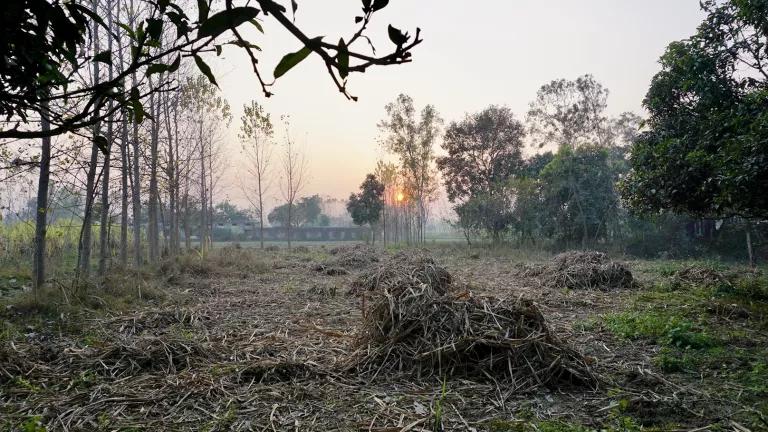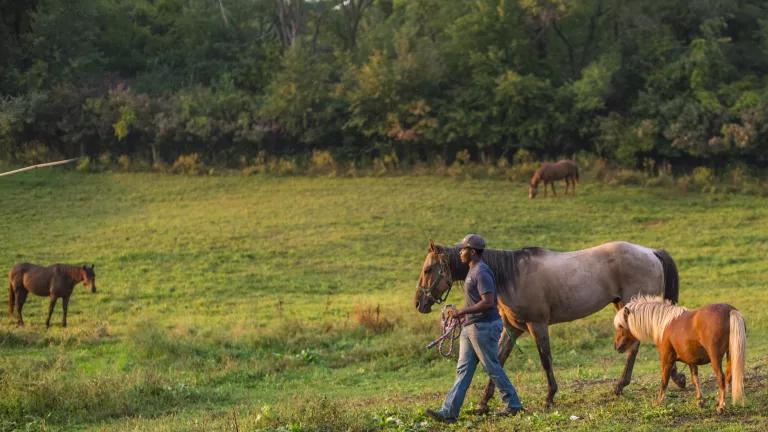Regenerative Agriculture Part 1: The Philosophy
The climate dread was quickly replaced with hope and joy as we learned from Indigenous stewards, Black and Brown farmers, and growers of all shapes, sizes, and in all geographies about how agriculture, and the soil under our feet, can help us combat climate change.

A Photo from Our Team Member’s Family Farm in India
This is part one of a blog series we have planned on regenerative agriculture. This first blog introduces the topic of regenerative agriculture and discusses regenerative philosophy; the second, third, and fourth will discuss regenerative principles, practices, and benefits.
Learning about Regenerative Agriculture
Biodiversity loss, rising sea levels, melting ice caps, water scarcity and pollution, food insecurity, toxic air quality, and intensified flooding and wildfires can really exacerbate climate dread. We’ve been feeling it here at NRDC. For the last year, we took a step back to reassess our programmatic direction and allowed ourselves the time and space to listen to and learn from others. The climate dread was quickly replaced with hope and joy as we learned from Indigenous stewards, Black and Brown farmers, and growers of all shapes, sizes, and in all geographies about how agriculture, and the soil under our feet, can help us combat climate change.
We started learning about soil health because the topic intersects very closely with our water conservation advocacy. Scientists, farmers and ranchers, public health experts, and ecologists, taught us about soil’s role in improving the water cycle, sequestering carbon, increasing biodiversity, reducing toxic pesticide and synthetic input use, improving rural livelihoods, providing climate resilience, and growing healthier foods. “Regenerative agriculture” was the phrase that kept coming up in those conversations.
We wanted to learn more, and we specifically wanted to learn more from people doing the actual work. Our team interviewed 115 farmers and ranchers across the country, and they taught us about the significant hurdles they must overcome to make the transition into, and scale up, regenerative agriculture on their land. Their experiences, and their stories of successes and hardships, are guiding our soil health advocacy. We want to share with you some of the big lessons we learned:
Regenerative agriculture is not a new idea.
This rebranded movement is an agricultural philosophy birthed by our Indigenous ancestors for over a millennium. Their ancestral agricultural wisdom is rooted in humility for Mother Nature. “Regenerate” comes from the Latin word regeneratus, which means “created again,” and it signifies harm was done and healing must begin. Regenerative agriculture means reversing the harm done to our soil and embracing agricultural practices that leave the land in better shape for future generations. Extrapolating further, regenerative agriculture asks us to think about how all aspects of agriculture are connected through a web—a complex network of entities who grow, add-value to, exchange, distribute, and consume agricultural goods and services—instead of through a linear supply chain. Within the web, we all add value to each other as part of a larger community and regenerate the Earth.

Karuk Food Crew Employee Collects Gooseberries
Regenerative agriculture cannot be defined.
As Ethan Soloviev and Gregory Landua write in ‘Levels of Regenerative Agriculture,’ defining regenerative agriculture would “put a wall around our agricultural landscapes, separating them from the natural world,” which is antithetical to the regenerative movement. They continue:
Regenerative agriculture’s aim is to regenerate “the health, vitality, and evolutionary capability of whole living systems.”
Focusing on definitions would restrict the complexity that connects soil to water, people, public health, culture, food, biodiversity, and other important parts of the ecosystem. A recent meta-analysis of papers written by scholars and practitioners confirms the dynamism around the words “regenerative agriculture.” Our team is following the advice of experts and of the farmers and ranchers we interviewed, and not fixating on a definition of regenerative agriculture. Instead, we are, as one farmer shared with us, “defining it by describing it” through its philosophy, principles, and practices.

Hmong Farmer Packing Vegetables, Flowers, and Edible Vegetation from Diverse Farm in California
Regenerative Philosophy: Farming and ranching in harmony with nature and the community
The farmers and ranchers we interviewed agree that regenerative agriculture, at its core, requires farming and ranching in harmony with nature. Regenerative agriculture asks growers to look at their land holistically and treat the soil, water, crops, people, and animals as elements of one connected system.
By contrast, the industrial agricultural system that dominates Western food and fiber supply chains today incentivizes agricultural practices that promote soil erosion at a rate 10 to 100 times higher than the soil formation rate; nutrient runoff and the increased severity of harmful algal blooms in freshwater and coastal systems; and the collapse of bee populations across the globe. This is the legacy of agricultural policies that commodify natural resources and myopically focus on the yields of individual crops.
With a focus on building soil health, regenerative farmers and ranchers take a broader view of their role in the world. They grow food and fiber, draw down carbon, conserve water, replenish waterways, grow healthier foods, reduce their use of synthetic inputs and chemicals, support and employ people within their communities, and ensure the long-term vitality of the land.

Rotational Grazing with Sheep at Paicines Ranch in California
In the next three blogs we’ll share more about the regenerative principles, practices, and benefits shared by our 115 interviewees. Our goal is to support the advocacy community, policy makers, farmers and ranchers, and individuals who are curious about how agriculture can help us combat climate change. Regenerative growers shared policy reforms that can inspire new regenerative growers, scale up existing regenerative practices, and ensure a level playing field for independent farmers and ranchers, especially Black, Indigenous, and other socially disadvantaged farmers and ranchers. Stay tuned for a comprehensive report that summarizes those policy recommendations and introduces other ideas to help transform our agricultural system into one that’s regenerative and healing.
If you’re itching to read what growers shared with us in the meantime, our team has been posting quotes from our interviews with the hashtag #FarmerFriday on NRDC’s social media channels. Follow along with our #FarmerFriday highlights on Twitter and Facebook to stay as inspired as we are.









